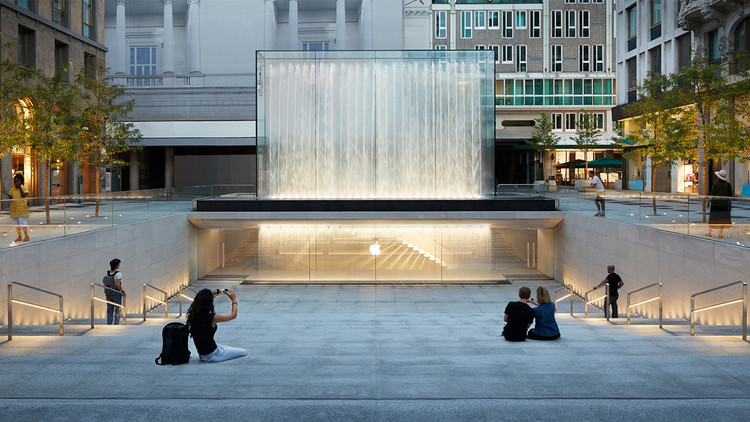
-
Architects: Bruno Rossi Arquitetos
- Area: 175 m²
- Year: 2017
-
Manufacturers: Ladrilar, Personal Refrigeração, reka iluminacao




A collection of stones piled one on top of the other, dry stone is an iconic building method found just nearly everywhere in the world. Relying solely on an age-old craft to create sturdy, reliable structures and characterised by its rustic, interlocking shapes, the technique has deep roots that stretch back even before the invention of the wheel. Its principles are simple: stack the stones to create a unified, load-bearing wall. But the efficient, long-lasting results, coupled with the technique’s cultural significance, have lead to continued use and updated interpretations all the way to contemporary architecture today.

Bjarke Ingels Group’s “The Eleventh” has marked a major milestone, with the first of the scheme’s two twisting High Line towers topping out in Chelsea, Manhattan. New images show construction moving quickly along, with the taller 35-story tower now topped out, and work on the cladding steadily progressing.
The 400-foot-tall structure will twist alongside a second 300-foot-tall sister tower, standing out even amongst notable neighbors including Frank Gehry’s IAC Building, Jean Nouvel’s 100 11th Avenue and Foster + Partners’ 551 West 21st Street.

Anoma, headed by EDIDA-winning Indian artist Ruchika Grover, is a product design studio that explores the potential of natural stone. Its surfaces, sculptures, and installations, are created through a unique process, which combines digital manufacturing and traditional hand craftsmanship.

Apple’s Piazza Liberty Store, designed by Foster + Partners, has opened to the public in Milan, Italy. The scheme is located under an existing piazza close to the Corso Vittorio Emanuele, one of the most popular pedestrian streets in Milan.
The store is defined by a dramatic waterfall which surrounds the entrance while forming the backdrop to a large outdoor amphitheater. Piazza Liberty is the first Apple Store to be constructed in Italy following their retail design collaboration with Foster + Partners.

Foster + Partners has published photographs of their recently-opened Apple Store in Macau, intended as a “new oasis of calm” against the city’s buzz and excitement. The store, opened on June 29th, was designed in response to a brief calling for “an inviting, contemplative space, where technology, entertainment, and arts come together to make a positive contribution to the city.”
Apple Cotai Central was designed in a close collaboration between Foster + Partners and Apple’s chief design officer Sir Jonathan Ive, a collaboration which has previously produced Apple stores at Michigan Avenue in Chicago, and Regent Street in London.
Architecture requires patience. Seeing a building through from initial sketches to the first occupant is a process that in most cases takes years, sometimes decades. The various details required throughout the building process at times can be stressful, but the end result is nearly always worth the struggle. The finished form reflects the decisions made throughout the process, and thus becomes a contributing member to the surrounding environment.
If you are at the point in the process where you need a quick destresser, take a moment and watch land artist Pontus Jansson work his magic. The Swedish artist uses boulders and the surrounding nature to create balancing works of art.
.jpg?1524158077)
Travel seven hours by car in a Southwest direction from Shanghai and you will arrive in Songyang County. The name is unfamiliar to many Chinese people, and even more foreign to those living abroad. The county consists of about 400 villages, from Shicang to Damushan.
Here, undulating lush green terraces hug the sides of Songyin river valley, itself the one serpentine movement uniting the lands. Follow the river and you will see: here, a Brown Sugar Factory; there, a Bamboo Theatre; and on the other side, a stone Hakka Museum built recently but laid by methods so old, even the town masons had to learn these ways for the first time, as if they were modern methods, as if they were revolutionary.
.jpg?1524158077)
And maybe they are. Songyang County, otherwise known as the “Last Hidden Land in Jiangnan,” may look like a traditional Chinese painting with craggy rock faces, rice fields and tea plantations, but it has also become a model example of rural renaissance. Beijing architect Xu Tiantian, of the firm DnA_Design and Architecture, has spent years surveying the villages of Songyang, talking to local County officials and residents, and coming up with what she calls “architectural acupunctures.”

Often as architects we neglect how the buildings we design will develop once we hand them over to the elements. We spend so much time understanding how people will use the building that we may forget how it will be used and battered by the weather. It is an inevitable and uncertain process that raises the question of when is a building actually complete; when the final piece of furniture is moved in, when the final roof tile is placed or when it has spent years out in the open letting nature take its course?
Rather than detracting from the building, natural forces can add to the material’s integrity, softening its stark, characterless initial appearance. This continuation of the building process is an important one to consider in order to create a structure that will only grow in beauty over time. To help you achieve an ever-growing building, we have collated six different materials below that age with grace.

New Fundamentals Research Group, in partnership with S.N.B.R., designed and fabricated a stone vaulted pavilion for Rocalia, a natural stone fair held in Lyon last month. At a total area of 36 square meters and 3.20 meters in height, Flux reconnects the past to the present by combining traditional sculptural design with contemporary fabrication processes.

More than a thousand meters above sea level on the slopes of the Alborz mountain range in Gilan, northern Iran, a remarkable village dating back to 1006 AD bustles with life. The unique ochre-brown structures of Masuleh follow the slope of the mountain that the village nestles on—or rather, grows from—giving the village its most unusual quality: the roofs of many of the houses connect directly to, or even form a part of, the street serving the houses above.

Italy-based New Fundamentals Research Group recently designed and built a full-scale prototype of an experimental barrel-vaulted stone structure for SNBR, a French company that specializes in cutting-edge stone construction. The structure is named Hypar Vault in a reference to the geometry of its constituent blocks; it uses two types of prefabricated stone modules—one type is the mirror image of the other—whose designs are based on the hypar (hyperbolic paraboloid), one of the only "doubly-ruled" surfaces in geometry. The use of these configurations allowed the vault to be constructed with almost zero wasted stone.

Stone is elemental to our built world. It is one of the oldest (if not the oldest) materials used in man-made habitats. The sense of timelessness in stone is attributed to its long and varied history alongside architecture. From ancient monoliths to cities to houses, the diversity of stone means that it can be used to convey a variety of expressions. Carved, polished, sedimented, stacked, preserved - the list can go on and on. The feeling stone conveys in contemporary projects usually brings with it a sense of place – a raw materiality when paired with timber or other natural materials. With that in mind, check out these 6 details of projects that stand out for their use of stone:

Bee Breeders have selected winners of the Stone Barn Meditation Camp competition, seeking to create a place of refuge for individuals amidst the pristine natural beauty of one of Latvia’s most remote regions. In announcing the competition results, the jury applauded the respect and regard shown to the environment by submitted schemes, commenting that the most successful projects stood out for their simplicity, elegance, and balance with nature.
The competition winners, including noted ‘Green’ and ‘Student’ schemes, are set out below.

Through a revisiting of Zaha Hadid's MAXXI Museum of Art in Rome and Heyder Aliyev Center in Baku, as well as the practice’s exploration of materiality and composition, Boffi_Code Kitchen is a custom kitchen island created by Zaha Hadid Design and Boffi, an Italian furniture company founded in 1934.
“Boffi_code offers customization to the highest standards, tailoring individual solutions with selected materials, finishes and cabinetry,” explains Zaha Hadid Design. “The Boffi_Code Kitchen by Zaha Hadid Design marries exceptional detailing and design with functionality, carefully chosen materials, and traditional craftsmanship.”

Helical staircases are often designed to be show-stoppers, focal points of architectural spaces that are intended to impress. But even compared to its eye-catching peers, this staircase developed by Webb Yates Engineers and The Stonemasonry Company is unusually audacious. Developed for a residential design by RAL Architects in Formby, UK, each step of the two-story, 4.6-meter diameter helical staircase is composed of an individual block of stone, giving an impression of weightlessness as the structure circles its way up through the building's atrium towards the glazed roof above. For their efforts, Webb Yates recently won the Award for Small Projects at the Institution of Structural Engineers' 2016 Structural Awards, whose judges said that they were "amazed by the grace and audacity" of the design. Read on to find out how Webb Yates achieved this feat of engineering.